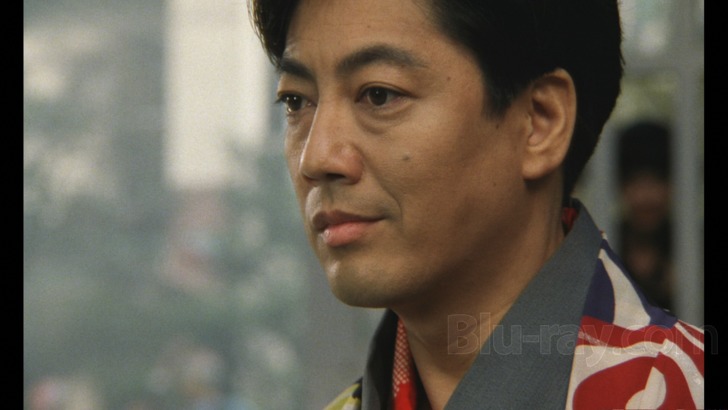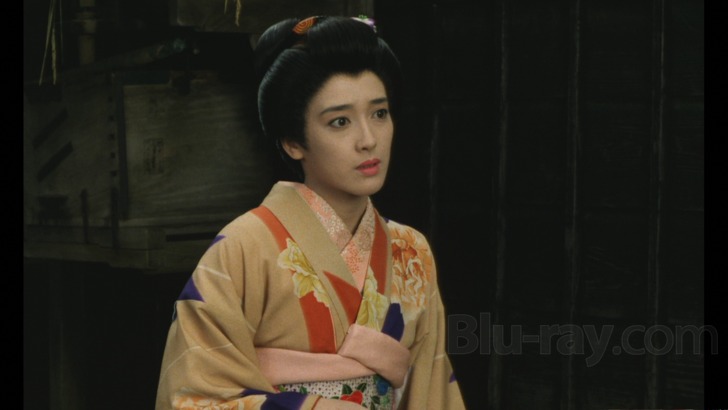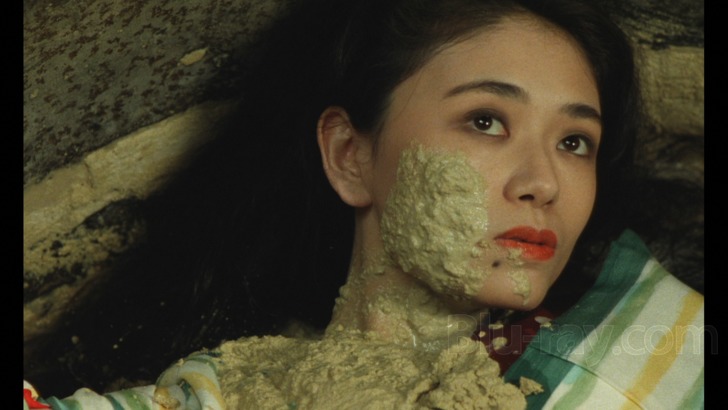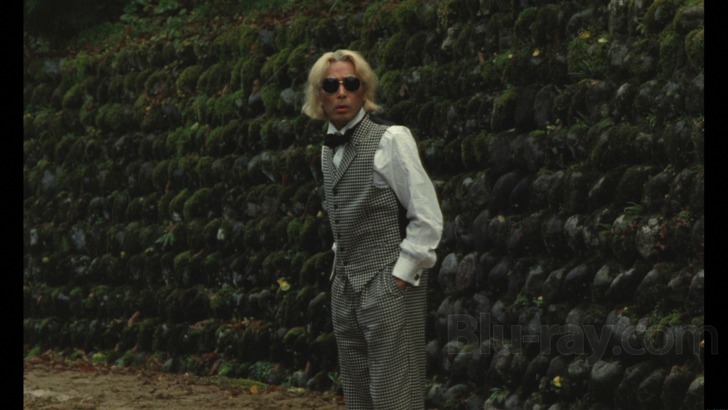Yumeji Blu-ray Movie
HomeYumeji Blu-ray Movie 
Blu-ray + DVD + Digital CopyArrow | 1991 | 128 min | Not rated | No Release Date

Price
Movie rating
6.9 | / 10 |
Blu-ray rating
| Users | 0.0 | |
| Reviewer | 3.5 | |
| Overall | 3.5 |
Overview
Yumeji (1991)
The life of Japanese artist and poet Yumeji Takehisa.
Starring: Kenji Sawada, Yoshio Harada, Tomoko Mariya, Masumi Miyazaki, Chikako MiyagiDirector: Seijun Suzuki
| Foreign | Uncertain |
| Drama | Uncertain |
| Surreal | Uncertain |
Specifications
Video
Video codec: MPEG-4 AVC
Video resolution: 1080p
Aspect ratio: 1.66:1
Original aspect ratio: 1.66:1
Audio
Japanese: LPCM 2.0
Subtitles
English SDH
Discs
Blu-ray Disc
Two-disc set (1 BD, 1 DVD)
Digital copy
DVD copy
Playback
Region A (B, C untested)
Review
Rating summary
| Movie | 3.5 | |
| Video | 4.0 | |
| Audio | 4.0 | |
| Extras | 1.5 | |
| Overall | 3.5 |
Yumeji Blu-ray Movie Review
Reviewed by Jeffrey Kauffman August 18, 2017Have you ever had a dream where something significant within it changed, and yet the dream and its internal logic seemed to continue unabated? I’ve had dreams were either I or someone else in the dream changed into someone else, and yet it was always clear who was whom and what was going on (again within the generally incomprehensible context of some of my dreams). I’m sure many of you have had a similar experience, maybe where a location in a dream suddenly morphs into someplace else, with no real concern resulting as far as the dreamer’s understanding goes. If you’re one of those rare people who have never had anything like these experiences, I need only suggest you spend a few minutes with Seijun Suzuki’s The Taishō Trilogy to get at least a hint of the feeling that ensues when a dream bizarrely transforms and yet just as bizarrely remains an organic whole unto itself. Suzuki had forged a long if not especially notable career churning out B movies for Nikkatsu, though his nascent auteur tendencies made him a bit of a persona non grata, ultimately leading to his firing (more or less, anyway) after Branded to Kill pushed the conservative studio bigwigs too far. A lawsuit and then ten years of more or less exile followed for Suzuki, but when he returned with The Taishō Trilogy, it was with those previously dismissed surreal tendencies not only intact, but arguably reinforced by his trek in the cinematic wilderness. The Taishō Trilogy takes its name from the Taishō Period in Japanese history, an era which stretched roughly from 1912 to 1926, though all three films in this set, Zigeunerweisen (1980), Kagero-za (1981) and Yumeji (1991), are so intentionally mythic or at least folkloristic that they often seemed to be divorced from any specific timeframe — much as with many dreams. Also as with the type of dreams referenced above, all three films waft in and out of general narrative coherence, with striking shifts in perspective and odd visual and verbal non sequiturs that may speak directly to the subconscious but which (perhaps unavoidably) present certain obstacles to the rational mind.

On its surface, Yumeji would seem to have offered Suzuki the most straightforward foundational elements of any of the three films in his Taishō Trilogy, since it ostensibly is a biography of an actual figure out of Japanese history, the poet and painter Yumeji Takehisa (portrayed in the film by Kenji Sawada). But merely taking the film’s opening sequence as one salient example, it is clear from virtually the get go that Yumeji resembles in no way most folks’ idea of a traditional “biopic”. The film starts with a bizarre scene of 1920s era Japanese people bouncing bright beach balls in a field, though Suzuki ups the visual ante by superimposing other, almost ghostly, visions of balls floating through the air. And, oh, there’s a woman standing in a tree, just for good measure. When Yumeji is introduced, it’s another bizarre character debut that is shorn of any context, with Yumeji seemingly involved in some kind of odd duel with a similarly context free assailant.
All three films in this trilogy have at least one character who is compelled almost against his will toward some other goal or character, and Yumeji himself seems almost pathologically obsessive about the opposite sex, though in his case it might be tangentially linked to his desire to paint beautiful women. A series of females interact with Yumeji in the film, often as seeming playthings for the artist, but he seems to develop a deeper connection to Tokoyo Wakiya (Tomoko Mariya), a widow reeling from the recent death of her husband (Yoshio Harada), who, somewhat similarly to aspects in the other films in the trilogy, shows up in ghost form to keep an eye on his erstwhile spouse.
While Yumeji tips into “Japanese Ghost Story” arguably more than the other two films in the trilogy, things are again presented so discursively, and some might argue intentionally opaquely, that the supernatural elements are less overtly spooky than simply kind of subliminally unsettling. Suzuki keeps the visuals decidedly on the surreal side, something that helps to give a bit of distance from overheated emotions and passionate sexuality. As Tony Rayns mentions in his introduction, the film may not have been helped by the casting of rock star Kenji Sawada. He tends to mug at times, and doesn’t quite have the easy grace that, say, David Bowie displayed in The Man Who Fell to Earth.
Yumeji Blu-ray Movie, Video Quality 

All three of the films in Seijun Suzuki's The Taishō Trilogy are presented on Blu-ray courtesy of Arrow Academy with AVC encoded 1080p transfers. Despite the verbiage reproduced from the insert booklet (below), Zigeunerweisen is in 1:34, Kagero-za is in 1.33:1 and Yumeji is in 1.66:1. While not quite as informative as some Arrow comments about their transfers, the insert booklet for the trilogy contains the following:
The films in The Taishō Trilogy have been restored by Free Stone Productions in Japan using the original film and audio elements. Zeigeunerweisen and Kageroza are presented in their original aspect ratios of 1.37:1. Yumeji is presented in it original aspect ratio of 1.66:1. The films contain their original mono soundtracks.Because all three of these transfer share certain characteristics, I'm going to make some general comments about all of them before moving on to each individual film. While all three boast elements that are either in excellent shape or have been digitally restored to appear so, I personally wished for just a bit more energy in the palette, will all three looking slightly anemic and in some cases skewed toward brown. Grain is very well resolved on all three features and the overall look of the transfers is commendably organic and stable.
Perhaps because of its relative newness, Yumeji is arguably the generally nicest looking transfer in the set. This is the sole film in the set with a (relatively) wide aspect ratio, and Suzuki fills the frame with a nice panoply of colors in everything from sets to costumes to natural locations. A few of the outdoor moments, including a sequence with a kind of mystical white horse, look slightly pallid, with greens never really resonating very well, but generally speaking, the palette in the film is fresher and more vivid looking than in the other two in the set. Fine detail is again nicely delivered, offering a number of precise looks at all sorts of textures that intrude, including everything from a fan with a drawing on it to some of the gorgeous kimonos the women wear.
Yumeji Blu-ray Movie, Audio Quality 

All three films in The Taishō Trilogy sport fine sounding LPCM 2.0 mono tracks in the original Japanese. The films all have rather interesting sound designs, with natural ambient environmental effects merging with sometimes detached feeling dialogue, and with sometimes unusual score choices added into the proceedings as well. All three tracks are unavoidably narrow sounding, but offer fine fidelity and no problems. Occasional "damage" creeps in with regard to things like the archival recording used in Zigeunerweisen.
Yumeji Blu-ray Movie, Special Features and Extras 

- Introduction by Tony Rayns (1080p; 24:19) is another good in depth piece that covers the long break between the second and third films, as well as thematic and stylistic elements shared by all three films.
- Making of Yumeji (1080i; 10:07) has some good behind the scenes footage. In Japanese with English subtitles.
- Theatrical Trailer (1080p; 4:37)
Yumeji Blu-ray Movie, Overall Score and Recommendation 

For me personally, Yumeji was the least compelling of the three films in the Suzuki set, perhaps due to some wobbliness on the part of Kenji Sawada, but frankly probably just as much due to Suzuki's odd choice to depict a kind of sexual obsessive in a weirdly dissociative way. This film does offer some of the most astounding visions of the entire trilogy, and for those who are willing not to be bothered by narrative inconsistencies, those visions may be enough to ensure a riveting viewing experience. With caveats noted, Recommended.
Similar titles
Similar titles you might also like
(Still not reliable for this title)

Zigeunerweisen
1980

Kagero-za
1981

Heroic Purgatory
煉獄エロイカ
1970

Eros + Massacre
エロス+虐殺
1969

Persona
1966

Poem
Uta / 哥
1972

The Ballad of Narayama
Narayama bushikô
1983

Through a Glass Darkly
Såsom i en spegel
1961

Killing
2018

The Incorrigible
悪太郎 / Akutarô
1963

Winter Light
Nattvardsgästerna
1963

The Rite
Riten / The Ritual
1969

To Joy
Till glädje
1950

The Boy Who Came Back
踏みはずした春 / Fumihazushita haru
1958

After the Rehearsal
Efter repetitionen
1984

Port of Call
Hamnstad
1948

The Silence
Tystnaden
1963

Thirst
Törst
1949

Cries and Whispers
Viskningar och rop
1972

Female Prisoner Scorpion: Beast Stable
1973